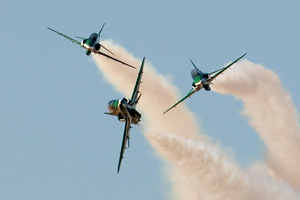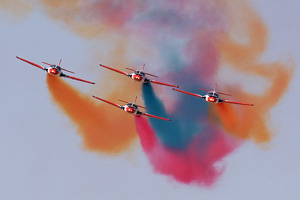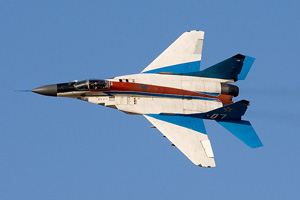Al Ain Aerobatic Show
Al Ain, United Arab Emirates
27-29 January 2007

|
Al Ain Aerobatic Show Al Ain, United Arab Emirates 27-29 January 2007
|
| This was the text that could be read on a banner towed by one of the (civil) participants of this year's Al Ain Aerobatics show. Arguably the first air show on the calender of 2007, at a time that at least in Europe winter isn't even over. Situated in the high desert of the United Arab Emirates, some 150 km from both Abu Dhabi as well as Dubai and close to the Omani border town of Al Buraimi, Al Ain is the annual venue of the UAE's Aerobatic Show. Climate forces the show's organisers to stage the event shortly after New Year's Day, as daytime temperatures would soar to unbearable levels during the summer. Even in January, the weather would not put a European event in June or July to shame, however, as the show's visitors enjoyed temperatures between 25 and 30°C with abundant sunshine. In fact, the only clouds seen during the first two days of this scribe's visit were those produced by the displaying aircraft. |
|
Apart from the Hawk, the UAE Air Force still posesses the Italian Aermacchi MB.339A as a primary jet trainer. Of the seven delivered, six are believed to be still active with the Flying Training Academy at Al Minhad. Regretfully, all the active aircraft were being kept in sun shelters. The scorching desert heat makes this an absolute necessity, however |
|
A new addition to the Transport Squadron's inventory appear to be at least a pair of Cessna Caravans. These were used to drop parachutists who during the show displayed their skills. On with the show, however, which sadly lacked any UAE Air Force participation other than the Caravans seen to the left.The show included many civilian aerobatics acts as well as American airshow acts unseen in Europe. The environmental and fire protection regulations were apparantly a bit more relaxed than in Europe, the results of which can be seen at the bottom of this page. |
|
The military oriented enthousiast however was treated with the sight of three rather exotic display teams in addition to the Chino-Pakistani K-8 Karakoram trainer. Named for the mountain range belonging to the Himalayas and separating China from Pakistan, the K-8 Karakoram is a jet trainer developed by those two countries. The type is set to replace the JJ-5 (licence built or copied MiG.15UTI) trainers in China as well as the Cessna T-37C's with the Pakistani Air Force. A pair of these aircraft were present, both displayed on different days. |
|
Of the aerobatic teams present during the Al Ain show, it were in the opinion of this writer the Saudi Hawks from the Royal Saudi Air Force that gave the best display. Clearly based upon the RAF's Red Arrows' display, The Saudi Hawks do incorporate some manoeuvres unique to this team, like the depiction of Saudi Arabia's national symbol, the palm tree with the crossed swords. The Saudi Hawks are officially known as No. 88 squadron and are based at Tabuk in northern Saudi Arabia. So far, the team has only displayed in the region, but would make a very welcome addition to the European airshow scene should they decide to do a European tour like their Jordanian counterparts often do. The Saudi Hawks could do a lot more than diplomats in restoring the country's image which was left tarnished after September 11. |
|
|

|
|
The Pakistani Air Force's other contribution to Al Ain's aerobatic airshow was the Sherdils team. Operated by the Air Force Academy at Risalpur near the northern town of Peshawar. Compared with their Saudi colleagues, the Sherdils, which means Lion Hearts, flew a rather sedate display without any of the opposition passes or breaks of other teams. Not visible in any of the images, the left hand seat of all the jet was replaced by a blue container, perhaps this is the diesel tank for smoke generation. Anyway, the Sherdils must be the only team in the world to boast four colours of smoke! |
|
|

|
|
The Russian Air Force team Striji (Swifts) flew arguably the loudest display in their MiG.29's. Also, they didn't need smoke generation to emphasize their manoeuvres, as is evidenced by the centre image below. Note that one of their aircraft was left in the teams previous colour scheme, with the other five sporting a new livery.Quite spectecularly, the Swifts start their display with the ejection of flares during a high speed pass. |
|
|

|
|
The show was closed by what has to be the most spectacular display of pyrotechnics ever whitnessed by this photographer. A line of oil drums was set ablaze with explosives resulting in a wall of fire hundreds of meters long. In front of this, a pair of civilian aerobatics aircraft, a Pitts S2S flown by Jim Leroy and a Sukhoi Su.26 flown by Jurgis Kayris displayed, including this crossover manoeuvre. In all, Al Ain provided lots of fun for action photographers. Digital photography really comes into its right at a place like this. Old school 50 mm Kodachrome shooters would not have been at home here, however. |
All pictures (c) Hans Rolink